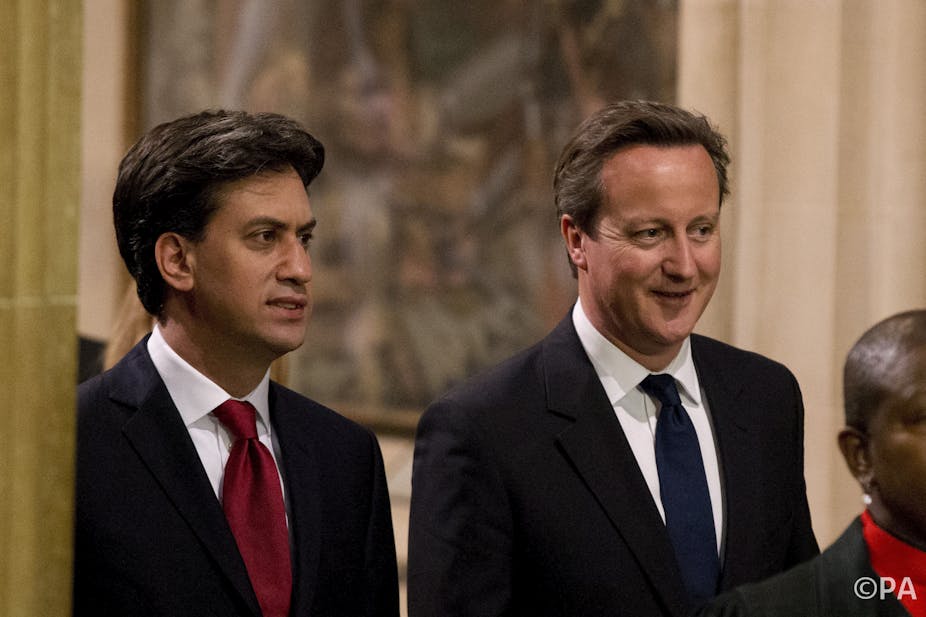Recent polls have put Labour and the Conservatives in what seems to be an unshakable dead heat. The latest Ashcroft poll puts them both on 33%. This takes the parties back to exactly where they were in the March 23 Ashcroft poll.
It seems as though neither party can do anything to nudge ahead, be it knocking on doors or making major pledges to voters. To understand why, we need to look at the key factors that drive voting behaviour.
There are four that are particularly important – approval of the government’s record, partisanship, evaluations of the leaders, and perceptions of party performance in relation to the most important issues in the election.

The chart shows trends in voting intentions in Britain over time, using data from the Essex Continuous Monitoring Survey. The current data shows that neither Labour nor the Conservatives have a significant advantage over the other, and are running pretty much neck-and-neck in the polls.
Approval of the government’s record provides a broad brush measure of how the governing party or parties are doing. The basic story here is that roughly a third of the voters approve and just over a half disapprove of the government’s record. This hasn’t changed over the past year.
Partisanship, or party identification, measures the brand loyalty that voters feel towards the parties. Many people do not have this, but it is an important factor in voting intention when they do. Currently, Labour and the Conservatives are neck-and-neck in partisanship. Labour had a slight advantage for a time but it had more or less disappeared by March 2015.
One interesting development is that UKIP has acquired loyal partisan supporters and they are comparable in number to the Liberal Democrats. Partisanship helps to provide a core or bedrock vote – since party identifiers are inclined to stay loyal even when a party is unpopular.
Getting personal
The third factor that drives the vote is public evaluations of the political leaders. This is a quick and easy way for voters to judge whether or not a government will be competently led – and even if the government will be effective. It turns out that the likeability of the leaders is a good summary measure of this factor since it is associated with other desirable leadership traits such as competence, trustworthiness and decisiveness.
The data shows that none of the four party leaders is particularly popular. They all score less than five on a ten-point likeability scale. However, Cameron does have an advantage over Miliband and both of these leaders have an advantage over Nick Clegg and Nigel Farage.
The Conservatives will undoubtedly pick up votes from having this advantage but not in huge numbers. On average, the distance between the two leaders is less than half a point on the ten-point scale. Another interesting development is that Nigel Farage appears to be losing ground on the scale, although he was ahead of Nick Clegg for most of 2014.
The big three
The fourth key factor which explains voting is issue perception, but only a handful of issues matter to most people. The surveys show that the economy is the leading issue, followed by the NHS and then immigration. Looking at changes over time, the economy has become slightly less important and immigration remains about the same, while the NHS has been growing in importance as the election approaches.
When asked if the government has done a good job or a bad job in managing these issues, respondents give the Conservatives good marks for the economy but poor marks for the NHS and abysmal marks for immigration. This is one of the reasons why the improvement in the economy observed over the last year has not greatly increased Conservative voting support.
Any extra credit the party receives for its performance on the economy is offset by its performance on immigration and to a lesser extent the NHS. Analysis shows that as far as these issues are concerned Conservatives are the focus of attention rather than the coalition government – this helps to explain why Liberal Democrat support has not improved over time.

There is another reason why an improved economic performance has not put the Conservatives ahead in the polls. Close to a half of survey respondents think that the national economy has done well over the previous year, but only about a fifth of them think that their own personal finances have improved. Thus many people feel that the economic recovery does not apply to them, and in addition about 30% think that no party is good at managing the economy. This scepticism about economic recovery is making it hard for the Conservatives to claim credit for the economy and win additional support.
Other factors are at work in influencing the vote but these are the main ones. And this is why Labour and the Conservatives are so close together in the polls. Neither of them have a significant advantage over the other on the key drivers of vote intentions. The election campaign might shift this, but it is looking increasingly unlikely that it will change things enough to avoid another hung parliament.

